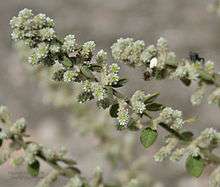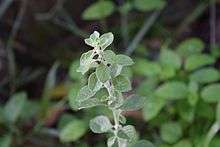Aerva lanata
Aerva lanata, the mountain knotgrass,[3] is a woody, prostrate or succulent, perennial herb in the family Amaranthaceae, native to Asia, Africa. It has been included as occurring in Australia by the US government,[1] but it is not recognised as occurring in Australia by any Australian state herbarium.[4] The plant sometimes flowers in the first year.[5][6]
| Aerva lanata | |
|---|---|
 | |
| Aerva lanata var. rotundifolia | |
| Scientific classification | |
| Kingdom: | Plantae |
| Clade: | Tracheophytes |
| Clade: | Angiosperms |
| Clade: | Eudicots |
| Order: | Caryophyllales |
| Family: | Amaranthaceae |
| Genus: | Aerva |
| Species: | A. lanata |
| Binomial name | |
| Aerva lanata | |
| Synonyms[2] | |
| |

Aerva lanata is a common weed which grows wild everywhere in the plains of India. The root has a camphor-like aroma. The dried flowers which look like soft spikes, are sold under the commercial names Buikallan and Boor. It is one of the plants included in Dasapushpam, the ten sacred flowers of Kerala.
Description

Mountain knotgrass is an annual with a branching, somewhat woody root system. The stems are mostly straggling and sprawling and spread widely, sometimes as much as 6 feet (1.8 m) in length. The often stalkless leaves are alternate, oval and 0.5 to 1.5 in (13 to 38 mm) long. They grow from whitish papery stipules with two lobes and red bases. The tiny clusters of two or three flowers grow in the leaf axils. The flowers are about 0.1 in (2.5 mm) long, pink, green or dull white. The flowers are normally self-pollinated. Flowering time is from May to October.[7]
Distribution and habitat
Aerva lanata is native to tropical Africa, South Africa, Madagascar, Saudi Arabia and tropical Asia.[1] The species prefers damper sites than Aerva javanica and can be found in open forests on mountain slopes, on waste and disturbed ground, deserted cultivation and coastal scrub[5] and at altitudes from sea level to 900 m (3,000 ft).[8] It is a common weed in arable fields and bare patches of ground.
Uses
This plant is used for food for people and animals. The whole plant, especially the leaves, is edible. The leaves are put into soup or eaten as a spinach or as a vegetable. The plant provides grazing for stock, game and chickens. The plant is used as a traditional medicine for snakebites.[7]
The plant is also used as a talisman against evil spirits, a good-luck talisman for hunters, and a talisman for the well-being of widows.[6]
In the traditional medicine of India, the juice of crushed Aerva lanata root is used for jaundice therapy.[9]
References
- "Aerva lanata". Germplasm Resources Information Network (GRIN). Agricultural Research Service (ARS), United States Department of Agriculture (USDA). Retrieved 2008-04-27.
- "Aerva lanata (L.) Juss. ex Schult. record n° 177". African Plants Database. South African National Biodiversity Institute, the Conservatoire et Jardin botaniques de la Ville de Genève and Tela Botanica. Archived from the original on 2007-10-12. Retrieved 2008-04-27.
- "Aerva lanata". EPPO Global Database. European and Mediterranean Plant Protection Organization (EPPO). Retrieved 2019-10-06.
- "Search: SPECIES: Aerva lanata". The Australasian Virtual Herbarium. Council of Heads of Australasian Herbaria. Retrieved 2018-03-20.
- Royal Botanic Gardens, Kew. "Amaranthaceae by C. C. Townsend". Flora Zambesiaca. Board of Trustees of the Royal Botanic Gardens, Kew. 9 (part:1). Retrieved 2008-04-28.
- "Aerva lanata (Linn.) Juss. [family AMARANTHACEAE]". Global Plants. JSTOR. Retrieved 2019-09-05.
- "Aerva lanata". Medicinal Plants Used For Snake Treatment. ToxicologyCentre.com. Archived from the original on 2013-12-13. Retrieved 2013-12-10.
- Robert Freedman (20 January 1998). "Famine Foods - AMARANTACEAE". Purdue University. Archived from the original on 6 April 2008. Retrieved 20 April 2008.
- Tewari D, Mocan A, Parvanov ED, Sah AN, Nabavi SM, Huminiecki L, Ma ZF, Lee YY, Horbańczuk JO, Atanasov AG. Ethnopharmacological Approaches for Therapy of Jaundice: Part I. Front Pharmacol. 2017 Aug 15;8:518. doi: 10.3389/fphar.2017.00518.
External links
| Wikimedia Commons has media related to Aerva lanata. |
| Wikispecies has information related to Aerva lanata |
- "Aerva lanata". Integrated Taxonomic Information System. Retrieved 27 June 2017.